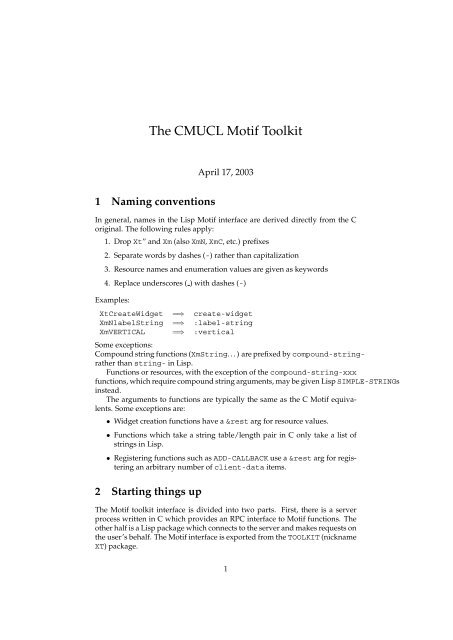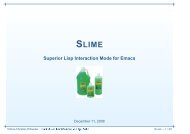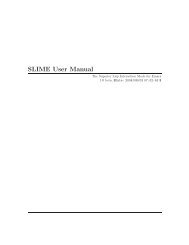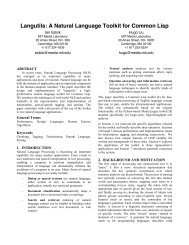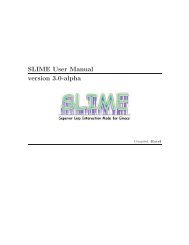The CMUCL Motif Toolkit - Common Lisp.net
The CMUCL Motif Toolkit - Common Lisp.net
The CMUCL Motif Toolkit - Common Lisp.net
- No tags were found...
You also want an ePaper? Increase the reach of your titles
YUMPU automatically turns print PDFs into web optimized ePapers that Google loves.
<strong>The</strong> <strong>CMUCL</strong> <strong>Motif</strong> <strong>Toolkit</strong>April 17, 20031 Naming conventionsIn general, names in the <strong>Lisp</strong> <strong>Motif</strong> interface are derived directly from the Coriginal. <strong>The</strong> following rules apply:1. Drop Xt” and Xm (also XmN, XmC, etc.) prefixes2. Separate words by dashes (-) rather than capitalization3. Resource names and enumeration values are given as keywords4. Replace underscores ( ) with dashes (-)Examples:XtCreateWidget =⇒ create-widgetXmNlabelString =⇒ :label-stringXmVERTICAL =⇒ :verticalSome exceptions:Compound string functions (XmString. . . ) are prefixed by compound-stringratherthan string- in <strong>Lisp</strong>.Functions or resources, with the exception of the compound-string-xxxfunctions, which require compound string arguments, may be given <strong>Lisp</strong> SIMPLE-STRINGsinstead.<strong>The</strong> arguments to functions are typically the same as the C <strong>Motif</strong> equivalents.Some exceptions are:• Widget creation functions have a &rest arg for resource values.• Functions which take a string table/length pair in C only take a list ofstrings in <strong>Lisp</strong>.• Registering functions such as ADD-CALLBACK use a &rest arg for registeringan arbitrary number of client-data items.2 Starting things up<strong>The</strong> <strong>Motif</strong> toolkit interface is divided into two parts. First, there is a serverprocess written in C which provides an RPC interface to <strong>Motif</strong> functions. <strong>The</strong>other half is a <strong>Lisp</strong> package which connects to the server and makes requests onthe user’s behalf. <strong>The</strong> <strong>Motif</strong> interface is exported from the TOOLKIT (nicknameXT) package.1
2.1 Variables controlling connections*DEFAULT-SERVER-HOST* A string naming the machine where the <strong>Motif</strong>server is to be found. <strong>The</strong> default is NIL, which causes a connection to bemade using a Unix domain socket on the local machine. Any other name mustbe a valid machine name, and the client will connect using Inter<strong>net</strong> domainsockets.*DEFAULT-DISPLAY* Determines the display on which to open windows.<strong>The</strong> default value of NIL instructs the system to consult the DISPLAY environmentvariable. Any other value must be a string naming a valid X display.*DEFAULT-TIMEOUT-INTERVAL* An integer specifying how many secondsthe <strong>Lisp</strong> process will wait for input before assuming that the connection to theserver has timed out.2.2 Handling ConnectionsOPEN-MOTIF-CONNECTION (hostname xdisplay-name app-name app-class)Opens a connection to a server on the named host and opens a display connectionto the named X display. <strong>The</strong> app-name and app-class are for definingthe application name and class for use in resource specifications. An optionalprocess-id argument can be passed if a local server process has already beencreated. This returns a MOTIF-CONNECTION object.CLOSE-MOTIF-CONNECTION (connection) This closes a toolkit connectionwhich was created by OPEN-MOTIF-CONNECTION.*MOTIF-CONNECTION* Bound in contexts such as callback handlers to thecurrently active toolkit connection.*X-DISPLAY* Bound in contexts such as callback handlers to the currentlyactive CLX display.WITH-MOTIF-CONNECTION ((connection) &body forms) This macroestablishes the necessary context for invoking toolkit functions outside of callback/eventhandlers.WITH-CLX-REQUESTS (&body forms) Macro that ensures that all CLXrequests made within its body will be flushed to the X server before proceedingso that <strong>Motif</strong> functions may use the results.RUN-MOTIF-APPLICATION (init-function) This is the standard CLMentry point for creating a <strong>Motif</strong> application. <strong>The</strong> init-function argument willbe called to create and realize the interface. It returns the created MOTIF-CONNECTION object. Available keyword arguments are:2
:init-args:application-class:application-name:server-host:displaylist of arguments to pass to init-functionapplication class (default "<strong>Lisp</strong>")application name (default "lisp")name of <strong>Motif</strong> server to connect toname of X display to connect toQUIT-APPLICATION () This is the standard function for closing down a<strong>Motif</strong> application. You can call it within your callbacks to terminate the application.3 <strong>The</strong> Server<strong>The</strong> C server is run by the motifd program. This will create both I<strong>net</strong> andUnix sockets for the <strong>Lisp</strong> client to connect to. By default, the I<strong>net</strong> and Unixsockets will be specific to the user.When a <strong>Lisp</strong> client connects to the server, it forks a copy of itself. Thus each<strong>Lisp</strong> application has an exclusive connection to a single C server process. Toterminate the server, just Ĉ it.Switches to change behavior:-global-local-noi<strong>net</strong>-nounix-nofork-traceSockets created for use by everyone rather than being userspecific.No I<strong>net</strong> socket is created and the Unix socket is process-specificInstructs the server not to create an I<strong>net</strong> socket.Instructs the server not to create a Unix socket.Will keep the server from forking when connections are made.This is useful when debugging the server or when you wantthe server to die when the application terminates.Will spit out lots of stuff about what the server is doing. This isonly for debugging purposes.Typically, users do not need to be concerned with server switches since, bydefault, servers are created automatically by your <strong>Lisp</strong> process. However, ifyou wish to share servers, or use servers across the <strong>net</strong>work, you will need torun the server manually.4 Widget creationCREATE-APPLICATION-SHELL (&rest resources)widget for a new <strong>Motif</strong> application.Creates the applicationShellCREATE-WIDGET, CREATE-MANAGED-WIDGET (name class parent &restresources) <strong>The</strong>se create new widgets. CREATE-WIDGET does not automaticallymanage the created widget, while CREATE-MANAGED-WIDGET does.CREATE- (parent name &rest resources) Conveniencefunction which creates a new widget of class . Forinstance, CREATE-FORM will create a new XmForm widget.3
*CONVENIENCE-AUTO-MANAGE* Controls whether convenience functions automaticallymanage the widgets they create. <strong>The</strong> default is NIL.5 CallbacksCallbacks are registered with the ADD-CALLBACK function. Unlike <strong>Motif</strong> in C,an arbitrary number of client-data items can be registered with the callback.Callback functions should be defined as:(defun callback-handler (widget call-data \&rest client-data) ... )<strong>The</strong> passed widget is that in which the callback has occurred, and the calldatais a structure which provides more detailed information on the callback.Client-data is some number of arguments which have been registered with thecallback handler. <strong>The</strong> slots of the call-data structure can be derived from the Cstructure name using the standard name conversion rules. For example, thecall-data structure for button presses has the following slot (aside from thestandard ones): click-count.To access the X event which generated the callback, use the following:(defun handler (widget call-data \&rest client-data)(with-callback-event (event call-data);; Use event structure here))Since callback procedures are processed synchronously, the <strong>Motif</strong> serverwill remain blocked to event handling until the callback finishes. This can bepotentially troublesome, but there are two ways of dealing with this problem.<strong>The</strong> first alternative is the function UPDATE-DISPLAY. Invoking this functionduring your callback function will force the server to process any pending redrawevents before continuing. <strong>The</strong> other (slightly more general) method is toregister deferred actions with the callback handling mechanism. Deferred actionswill be invoked after the server is released to process other events and thecallback is officially terminated. Deferred actions are not invoked if the currentapplication was destroyed as a result of the callback, since any requests to theserver would refer to an application context which was no longer valid. <strong>The</strong>syntax for their usage is:(with-callback-deferred-actions )You may register only one set of deferred actions within the body of anyparticular callback procedure, as well as within event handlers and action procedures.Registering a second (or more) set of deferred actions will overwriteall previous ones.When using deferred action procedures, care must be taken to avoid referencinginvalid data. Some information available within callbacks is only validwithin the body of that callback and is discarded after the callback terminates.For instance, events can only be retrieved from the call-data structure withinthe callback procedure. Thus the code4
(with-callback-deferred-actions(with-callback-event (event call-data)(event-type event)))is incorrect since the event will be fetched after the callback is terminated,at which point the event information will be unavailable. However, the code(with-callback-event (event call-data)(with-callback-deferred-actions(event-type event)))is perfectly legitimate. <strong>The</strong> event will be fetched during the callback andwill be closed over in the deferred action procedure.6 Action proceduresAction procedures can be registered in translation tables as in the followingexample: q: <strong>Lisp</strong>(SOME-PACKAGE:MY-FUNCTION)\n<strong>The</strong> generating X event can be accessed within the action handler using:(with-action-event (event call-data)... use event here ...)7 Event handlersX events are also represented as structured objects with slot names which aredirectly translated from the C equivalent. <strong>The</strong> accessor functions are named by-. Some examples:(event-window event)(event-type event)This applies to all eventsSo does this(button-event-x event) Some button event(button-event-button event) accessorsAt the moment, XClientMessage and XKeyMap events are not supported(they will be in the not too distant future).Provided conveniencesSince <strong>Motif</strong> requires the use of font lists for building non-trivial compoundstrings, there are some <strong>Lisp</strong> functions to ease the pain of building them:BUILD-SIMPLE-FONT-LIST (name font-spec) Returns a font list of withthe given name associated with the given font. For example,(build-simple-font-list "MyFont" "8x13")5
BUILD-FONT-LIST (flist-spec) This allows for the construction of fontlists with more than one font. An example:(build-font-list ‘(("EntryFont" ,entry-font-name)("HeaderFont" ,header-font-name)("ItalicFont" ,italic-font-name)))<strong>The</strong>re are certain callbacks which are of general use, and standard ones areprovided for the programmer’s convenience. For all callbacks except QUIT-APPLICATION-CALLBACK,you register some number of widgets with ADD-CALLBACK. <strong>The</strong>se will be thewidgets acted upon by the callback:Callback to terminate the current ap-QUIT-APPLICATION-CALLBACK ()plication.DESTROY-CALLBACKMANAGE-CALLABCKUNMANAGE-CALLBACKDestroys all the widgets passed to it.Manages all the widgets passed to it.Unmanages all the widgets passed to it.POPUP-CALLBACKPOPDOWN-CALLBACKCalls popup on all widgets passed to it.Calls popdown on all widgets passed to it.8 Some random notes• When using functions such as REMOVE-CALLBACK, the client-data passedmust be EQUAL to the client-data passed to ADD-CALLBACK.• When using REMOVE-CALLBACK, etc., the function may be supplied aseither ’FUNCTION or #’FUNCTION. However, they are considered differentso use the same one when adding and removing callbacks.• You cannot directly access the XmNitems resources for List widgets andrelatives. Instead, use (SET-ITEMS ....) and (GET-ITEMS).9 Things that are missing• Real documentation• Support for XClientMessage and XKeyMap events• Callback return values (e.g. XmTextCallback’s)• Ability to send strings longer than 4096 bytes.6
10 A brief example<strong>The</strong> following gives a simple example that pops up a window containing a“Quit” button. Clicking on the button exits the application. Note that the applicationruns concurrently with <strong>CMUCL</strong>: you can evaluate forms in the listenerwhile the <strong>Motif</strong> application is running. Exiting the application does notcause <strong>CMUCL</strong> to exit; once you have quit the application, you can run it again.To run this example, save the code to a file named motif-example.lispand in the <strong>CMUCL</strong> listener, typeUSER> (compile-file "motif-example"); Loading #p"/opt/cmucl/lib/cmucl/lib/subsystems/clm-library.x86f".;; Loading #p"/opt/cmucl/lib/cmucl/lib/subsystems/clx-library.x86f".; Byte Compiling Top-Level Form:; Converted my-callback.; Compiling defun my-callback:; Converted test-init.; Compiling defun test-init:; Converted test.; Compiling defun test:; Byte Compiling Top-Level Form:#p"/home/<strong>CMUCL</strong>/motif-example.x86f"nilnilUSER> (load *); Loading #p"/home/<strong>CMUCL</strong>/motif-example.x86f".tUSER> (motif-example:test)#Got callback on #Callback reason was cr-activateQuit button is #USER> (quit)7
<strong>The</strong> source code:;;; file motif-example.lisp(eval-when (:load-toplevel :compile-toplevel)(require :clm))(defpackage :motif-example(:use :cl :toolkit)(:export #:test))(in-package :motif-example)(defun my-callback (widget call-data quit)(format t "Got callback on ˜A˜%" widget)(format t "Callback reason was ˜A˜%" (any-callback-reason call-data))(format t "Quit button is ˜A˜%" quit))(defun test-init ()(let* ((shell (create-application-shell))(rc (create-row-column shell "rowColumn"))(quit (create-push-button-gadget rc "quitButton":label-string "Quit"))(button (create-push-button-gadget rc "button":highlight-on-enter t:shadow-thickness 0:label-string "This is a button")))(add-callback quit :activate-callback #’quit-application-callback)(add-callback button :activate-callback ’my-callback quit)(manage-child rc)(manage-children quit button)(realize-widget shell)))(defun test ()(run-motif-application ’test-init))8


